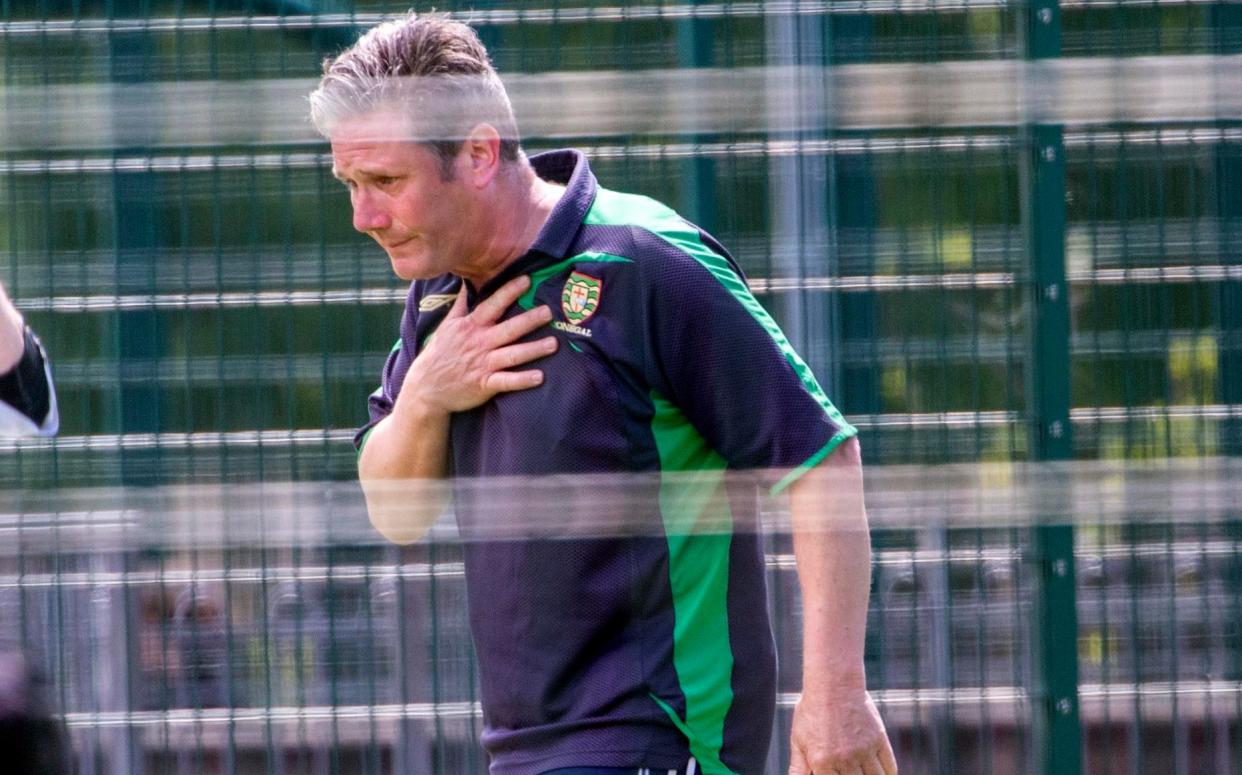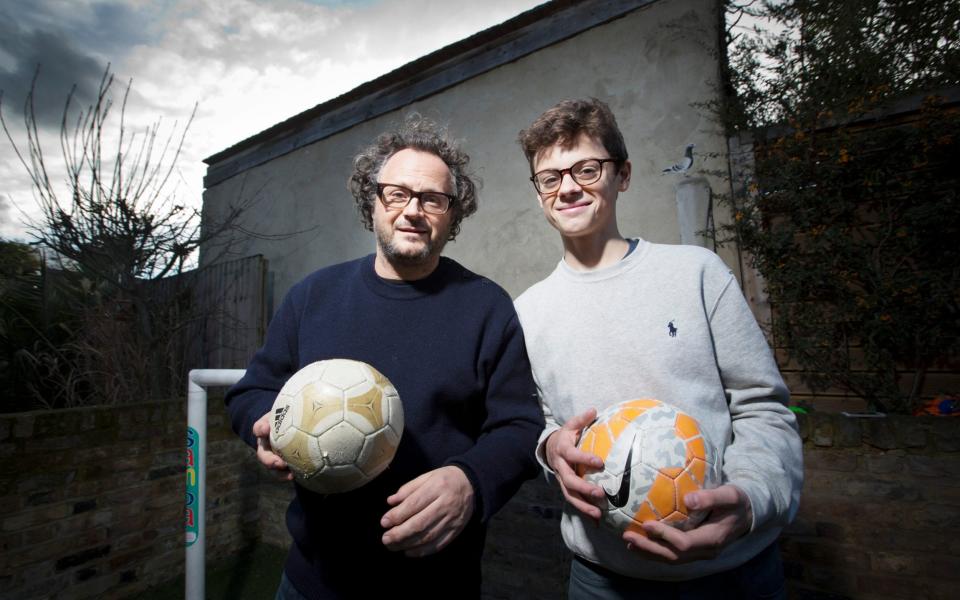Like Keir Starmer, I know nothing gets between a midlife bloke and playing football

It’s every middle-aged out of shape amateur footballer’s nightmare. Someone brings a camera to the game and captures you in all your huffing puffing tight-shirted glory, shattering a thousand delusional inner commentaries. In those photos you realise you are not the younger version of yourself that compels you to keep playing – nor do you look anything like the stylish Italian greats like Maldini or Pirlo, or the super lean heroes of your Seventies childhood.
Photos emerged on the weekend of Keir Starmer looking less than match fit, doubled over and puffing, before finishing the game with a pint. Having been his teammate on a number of occasions previously on Sunday mornings in north London, I knew his game as organised, his captaincy skilful – it was fair to predict he might be heading for a higher role in politics. Contrary to those photographs Keir is very good to play with: he’s solid, not flashy and works hard, which is probably why he looked so knackered. He wasn’t much of a goalscorer, it has to be said, and his “shoot to miss” policy might need some sort of parliamentary investigation.
It doesn’t surprise me he’s not stopped despite his new job: for many of us amateur football is the last true link between the dreams we had as kids and the lives we lead today. Especially in a season when we can’t even watch our professional teams live. I’ve kept going too – in spite of having similarly unflattering photos of me mid-match broadcast when I wrote Above Head Height, my book about five-a-side football. An Amazon number one bestseller, newspapers, magazines and Match of The Day: The Premier League Show sent photographers and cameramen to shoot me and my friends. I have never looked so static in all my life. I used to be a box-to-box midfielder; now the only box I’m likely to be getting into is one covered in wreaths.
For men in midlife, giving up a kickabout just isn’t an option. I still play two games a week despite health issues which suggest I really shouldn’t. I can’t see, I can’t hear, I have asthma, my insteps have gone but I have no intention to stop, I still have a decent game two out of three weeks. The people I play with range in age from 15 to 73, it’s the same all over the country. Self-organised small-sided games are going on everyday in every city and town in the UK and companies like Power League offer a platform for avid five-a-side nuts, but beyond that there are any number of leisure centres and schools renting their pitches to an array of ageing men and now women in new and vintage kits of their heroes. Admittedly the demand to play in my regular Friday night game once lockdown allowed it again at Easter was naturally greater than on a rainy February night and we’ve been sailing at full capacity ever since.
Amateur astroturf football is a great leveller. For those 60 or 90 minutes it doesn’t matter what you do for a living, where you’re from, who you support. There are bonds formed that transcend normal social boundaries. Last Friday I found myself stood outside our local pub having the post-match debrief where people who shoot from the halfway line are forced to explain their actions, and temporary goalkeepers who give the ball away to the opposition striker to score are mocked mercilessly. This time I was with four Manchester United fans, which as a Leeds United fan is not a date I would otherwise arrange, but we played together so we drank together.

The week before, five of us regulars had retired to another player’s back garden when the pub was too full to allow us into theirs. There we sat in his building site of a back garden round a fire pit, going over and over the game until past midnight. By the time I stepped away from the fire I was utterly freezing in the dark black night in just nylon shorts and football shirt, the sunlight from when I’d set off five hours earlier long gone.
Amateur football does this, it consumes you. It brings people together: you might not know their surnames or what their personal or professional status are but you’ll know if they are a generous player or a gifted finisher or someone who spends too much time telling other players to do things they don’t do themselves.
Most importantly it takes you away from the pressures of the world and just for a moment, even if you look extremely unfit in ageing kit, you might make a tackle or a pass that stays with you for ages. And you might even indulge in telling people who have no interest whatsoever all about it endlessly, as the woman watching me type this has to put up with. I imagine it’s the same at Keir’s house.
Above Head Height: A Five-A-Side Life by James Brown (Quercus). Preorder now for £9.99 at books.telegraph.co.uk or call 0844 871 1514
How to avoid a midlife sports injury
Cara McGoogan
Keep focused
“Team sport has to be the most fun way to exercise, but it’s also probably the easiest way to get injured,” says Sarah Lindsay, former Olympic speed skater. “You’re distracted by the game and competition, and not focused on what you’re feeling and what’s happening to the body.”
Try not to divert entire focus to the game, but what your body is saying – rolled ankles, pulled muscles and a torn anterior cruciate ligament (ACL) are easily done, so ease in with some gentle exercises where possible first.
Build your strength
After more than a year of being restricted in what exercise you can do, accept that you’re going to be slower and less skilled than you were at the beginning of 2020. “If you used to train for an hour, start with 20 minutes,” says Greg Cornthwaite, calisthenics champ and strength trainer. “If you were used to playing for 80 or 90 minutes pre-lockdown, maybe look at starting with 45 minutes and build up from there.”
Diversify each workout
Whether it’s slowing down your running speed or holding back on extra repetitions, not going full-pelt at all times means “you should be able to train almost every day,” says Cornthwaite, who advises to “up the intensity every 2-3 days.”
You should also change up your routine so your whole body gets stronger. If you have been running and lunging, make sure to wave in some balance drills. Try a Clock Reach, where you stand on one leg and touch the other foot to a series of positions around your body. Also try a side lunge or Bulgarian split squat.
Warm up properly
Warm up before you play with dynamic movements that mimic the sport you’re doing. If it’s tennis, warm up with some arm swings and a knockabout; if five-a-side, try Carioca drills (side-stepping moves that improve agility and lateral movement).
...and cool down too
Experts advise bringing exercise to a close with slower movements, stretching out the areas you have worked. Some Epsom salts in the bath and a proper protein powder can do wonders for recovery, as will a good night’s sleep. “If you do end up hobbling the next day, focus on good nutrition and hydration to reduce inflammation,” says Lindsay.


